As an avid fan of fantasy and science fiction, I have had a wealth of good reading in the genre throughout 2016. Here is a sample of those books I found particularly engaging. They introduce readers to traditional characters, including fairies, griffins, and Bigfoot, as well as to humans who have fantastical adventures in the past, present, or future. These books offer readers the opportunity to exercise their imagination.
Ages 4–8
A Fairy Friend. Sue Fliess. Ill. Claire Keane. 2016. Christy Ottaviano/Henry Holt.
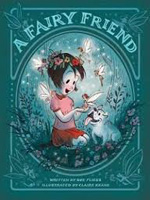 A gentle rhyming text and dreamy, soft watercolor illustrations by a Disney animator present the story of a young girl who has read in her Fairies book that “Friendly fairies soar the skies. / Ride the backs of dragonflies.” She doesn’t see any fairies even though they are all around. However, as the illustrations show, her bulldog sees them flitting everywhere. She follows the directions in her book for attracting a fairy by building a special house of twigs and blooms, and a fairy friend comes to her. The girl also learns that when it’s time to let her forever friend go “...if you’re thoughtful, kind, and true, / Your fairy will return to you!” Young children are sure to want to make their own fairy houses after enjoying this imaginative tale.
A gentle rhyming text and dreamy, soft watercolor illustrations by a Disney animator present the story of a young girl who has read in her Fairies book that “Friendly fairies soar the skies. / Ride the backs of dragonflies.” She doesn’t see any fairies even though they are all around. However, as the illustrations show, her bulldog sees them flitting everywhere. She follows the directions in her book for attracting a fairy by building a special house of twigs and blooms, and a fairy friend comes to her. The girl also learns that when it’s time to let her forever friend go “...if you’re thoughtful, kind, and true, / Your fairy will return to you!” Young children are sure to want to make their own fairy houses after enjoying this imaginative tale.
Henry & Leo. Pamela Zagarenski. 2016. Houghton Mifflin Harcourt.
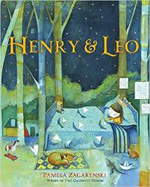 This evocative read-aloud about friendship and love is accompanied by enchanting mixed-media illustrations. Henry has loved Leo, his stuffed lion and his best friend, since he got him on his second birthday. For Henry, Leo is real. After Henry and his family return home from a walk in the Nearby Woods, Henry realizes that Leo is no longer with him. He tells his mother, “Leo will be scared.” She replies, “He is real only in your imagination,” and promises that they will search for Leo in the morning. That night, Henry dreams (shown in exquisite wordless double-page spreads) that other stuffed animals—a bear, a fox, and a hare—from his bedroom come alive and search for Leo in the woods. They leave Leo by the front door, where Henry is reunited with him in the morning. There is more for children to discover and to think about with each rereading of Henry & Leo.
This evocative read-aloud about friendship and love is accompanied by enchanting mixed-media illustrations. Henry has loved Leo, his stuffed lion and his best friend, since he got him on his second birthday. For Henry, Leo is real. After Henry and his family return home from a walk in the Nearby Woods, Henry realizes that Leo is no longer with him. He tells his mother, “Leo will be scared.” She replies, “He is real only in your imagination,” and promises that they will search for Leo in the morning. That night, Henry dreams (shown in exquisite wordless double-page spreads) that other stuffed animals—a bear, a fox, and a hare—from his bedroom come alive and search for Leo in the woods. They leave Leo by the front door, where Henry is reunited with him in the morning. There is more for children to discover and to think about with each rereading of Henry & Leo.
Nobody Likes a Goblin. Ben Hatke. 2016. First Second/Roaring Brook.
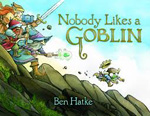 Goblin lives in his homey dungeon with bats and rats. After a band of adventurers kidnap his best friend, Skeleton, from the Treasure Room, Goblin goes on a quest to bring back Skeleton—and the stolen treasure. Along the way he meets trolls, villagers, and elves who don’t like him. When Goblin finally finds Skeleton, they hide in a cave that houses a crowd of goblins who, seeing him wearing Skeleton’s crown, proclaim him their King of the Goblins. The new goblin friends defend Goblin and Skeleton, chase away their tormentors, and retrieve the stolen treasure. Goblin and Skeleton return home together, demonstrating that true friends accept you for who you are without judgment. The artful placement of text alongside watercolor-and-ink illustrations in interesting layouts in separate frames in this grand adventure story give young children the feel of reading a graphic novel.
Goblin lives in his homey dungeon with bats and rats. After a band of adventurers kidnap his best friend, Skeleton, from the Treasure Room, Goblin goes on a quest to bring back Skeleton—and the stolen treasure. Along the way he meets trolls, villagers, and elves who don’t like him. When Goblin finally finds Skeleton, they hide in a cave that houses a crowd of goblins who, seeing him wearing Skeleton’s crown, proclaim him their King of the Goblins. The new goblin friends defend Goblin and Skeleton, chase away their tormentors, and retrieve the stolen treasure. Goblin and Skeleton return home together, demonstrating that true friends accept you for who you are without judgment. The artful placement of text alongside watercolor-and-ink illustrations in interesting layouts in separate frames in this grand adventure story give young children the feel of reading a graphic novel.
Ages 9–11
Hatched (The Enchanted Files #2). Bruce Coville. 2016. Random House.
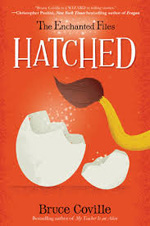 Timid griffling Gerald Overflight (a triplet) from the Enchanted Realm, on his quest for a treasure for his important Tenth Hatchday Ceremony, is spurred on by his gnome tutor, Abelard Chronicus, who has ulterior motives for traveling to the human world. Bradley Ashango is spending the summer at his grandmother’s farm in the Catskill Mountains where he and Gerald meet by accident in the barn. They unite to save nearby New Batavia—home to a colony of gnomes living underground—from being developed into wetlands by capturing two dozen large pink bunnies from the Enchanted Realm and transplanting them as an endangered species. Gerald not only earns his tenth treasure, a gold medal, but also recognition for his bravery in confronting a dragon and saving the gnomes. The humor of this adventure story of bravery and friendship between human and magical worlds (told from multiple points of view with “authentic” documentation) will surely entertain fantasy-loving middle-grade readers.
Timid griffling Gerald Overflight (a triplet) from the Enchanted Realm, on his quest for a treasure for his important Tenth Hatchday Ceremony, is spurred on by his gnome tutor, Abelard Chronicus, who has ulterior motives for traveling to the human world. Bradley Ashango is spending the summer at his grandmother’s farm in the Catskill Mountains where he and Gerald meet by accident in the barn. They unite to save nearby New Batavia—home to a colony of gnomes living underground—from being developed into wetlands by capturing two dozen large pink bunnies from the Enchanted Realm and transplanting them as an endangered species. Gerald not only earns his tenth treasure, a gold medal, but also recognition for his bravery in confronting a dragon and saving the gnomes. The humor of this adventure story of bravery and friendship between human and magical worlds (told from multiple points of view with “authentic” documentation) will surely entertain fantasy-loving middle-grade readers.
The Imagination Box (The Imagination Box #1). Martyn Ford. 2016. Delacorte/Random House.
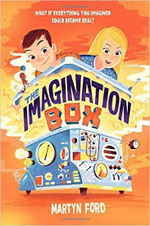 Lonely 10-year-old Tim lives at Dawn Star Hotel with his adoptive parents, Lisa and Chris, who pretty much leave him to entertain himself. When he meets scientist and inventor Professor Eisenstone and accidentally harnesses his imagination to the professor’s mind-harnessing machine, creating a burnt sausage, the professor declares him a genius (with an admonition to keep this a secret). Emboldened, Tim corrals his fertile thoughts and produces a miniature monkey as a play companion. His best creation, however, is an Imagination Box that comes with its own nightmare consequences. When Professor Eisenstone disappears, Tim enlists the aid of the professor’s granddaughter, Dee, to search for him. In a horrific turn of events with several narrow escapes, Tim uncovers a complicated, sinister plot against Professor Eisenstone that began decades earlier. The cliffhanger ending, fueled by Tim’s glimpse into the soul of evil and his unbridled imagination, sets readers up for the next book in this science fiction trilogy.
Lonely 10-year-old Tim lives at Dawn Star Hotel with his adoptive parents, Lisa and Chris, who pretty much leave him to entertain himself. When he meets scientist and inventor Professor Eisenstone and accidentally harnesses his imagination to the professor’s mind-harnessing machine, creating a burnt sausage, the professor declares him a genius (with an admonition to keep this a secret). Emboldened, Tim corrals his fertile thoughts and produces a miniature monkey as a play companion. His best creation, however, is an Imagination Box that comes with its own nightmare consequences. When Professor Eisenstone disappears, Tim enlists the aid of the professor’s granddaughter, Dee, to search for him. In a horrific turn of events with several narrow escapes, Tim uncovers a complicated, sinister plot against Professor Eisenstone that began decades earlier. The cliffhanger ending, fueled by Tim’s glimpse into the soul of evil and his unbridled imagination, sets readers up for the next book in this science fiction trilogy.
The Littlest Bigfoot (Littlest Bigfoot #1). Jennifer Weiner. 2016. Aladdin/Simon & Schuster.
 Twelve-year-old Alice has never fit in with her socialite parents at home or at any of her prior seven schools. Even though her new boarding school, The Experimental Center for Love and Learning, strives for inclusivity, she is bullied for her large size and mass of unruly hair. Millie, a young member of the Yare (Bigfoot) tribe, feels unappreciated by her family and yearns to sing on television with No-Furs (humans), but contact with humans is strictly forbidden. The two become friends when Alice saves Millie from drowning in a lake. When outcast Jeremy and his techy wheelchair-bound friend Jo, intent on discovering a Bigfoot, stumble across compelling evidence that threatens to expose Millie’s secrets, Alice and Millie heroically execute a plan to save the Yare community. An unexpected revelation will pull middle-grade readers into the next book in the series.
Twelve-year-old Alice has never fit in with her socialite parents at home or at any of her prior seven schools. Even though her new boarding school, The Experimental Center for Love and Learning, strives for inclusivity, she is bullied for her large size and mass of unruly hair. Millie, a young member of the Yare (Bigfoot) tribe, feels unappreciated by her family and yearns to sing on television with No-Furs (humans), but contact with humans is strictly forbidden. The two become friends when Alice saves Millie from drowning in a lake. When outcast Jeremy and his techy wheelchair-bound friend Jo, intent on discovering a Bigfoot, stumble across compelling evidence that threatens to expose Millie’s secrets, Alice and Millie heroically execute a plan to save the Yare community. An unexpected revelation will pull middle-grade readers into the next book in the series.
Ages 12–14
Children of Exile (Children of Exile #1). Margaret Peterson Haddix. 2016. Simon & Schuster.
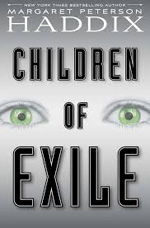 The children of Fredtown, a simple, peaceful, polite, and well-run society, learn they are not orphans after all and will be returned home to their parents, who were forced to give them up at birth. Rosi, the oldest girl at age 12, does her best to make the transition smooth for the younger children. However, from the beginning of the disastrous flight home to their reception by their poor, damaged parents who don’t know what to do with them, nothing bodes well. Rosi soon discovers scary and monstrous things afoot at night, and she is arrested and incarcerated when she stands up to injustice. Just as she realizes her parents do love her, Rosi uncovers the unbelievable reality of who the Enforcers and the Freds are. On the run with her brother and another child, Rosi must decide where they belong, leaving readers in suspense and eager for the sequel.
The children of Fredtown, a simple, peaceful, polite, and well-run society, learn they are not orphans after all and will be returned home to their parents, who were forced to give them up at birth. Rosi, the oldest girl at age 12, does her best to make the transition smooth for the younger children. However, from the beginning of the disastrous flight home to their reception by their poor, damaged parents who don’t know what to do with them, nothing bodes well. Rosi soon discovers scary and monstrous things afoot at night, and she is arrested and incarcerated when she stands up to injustice. Just as she realizes her parents do love her, Rosi uncovers the unbelievable reality of who the Enforcers and the Freds are. On the run with her brother and another child, Rosi must decide where they belong, leaving readers in suspense and eager for the sequel.
The Haunting of Falcon House. Eugene Yelchin. 2016. Henry Holt.
 Twelve-year-old Prince Lev Lvov leaves his beloved mother to travel to czarist Saint Petersburg in 1891 to claim his title as master of Falcon House. Instead of being greeted as a long-lost relative and leader, he is treated oddly and nothing is what it appears to be. Lev aspires to be like his grandfather, who was a powerful general in the Russian army, but he soon discovers that Grandfather had a dark side. He wonders why his aunt is so harsh with the staff that is terrified of her. Lev begins drawing cryptic pictures in his sleep, uncovers a ghost story, and slowly unravels many secrets surrounding Falcon House. This compelling mystery is unveiled through Lev’s narrative insights, sketches, endnotes, and footnotes which may lead readers to historical, research, and other literary connections.
Twelve-year-old Prince Lev Lvov leaves his beloved mother to travel to czarist Saint Petersburg in 1891 to claim his title as master of Falcon House. Instead of being greeted as a long-lost relative and leader, he is treated oddly and nothing is what it appears to be. Lev aspires to be like his grandfather, who was a powerful general in the Russian army, but he soon discovers that Grandfather had a dark side. He wonders why his aunt is so harsh with the staff that is terrified of her. Lev begins drawing cryptic pictures in his sleep, uncovers a ghost story, and slowly unravels many secrets surrounding Falcon House. This compelling mystery is unveiled through Lev’s narrative insights, sketches, endnotes, and footnotes which may lead readers to historical, research, and other literary connections.
The Seventh Wish. Kate Messner. 2016. Bloomsbury.
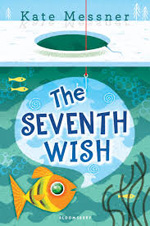 It was one thing when 12-year-old Charlie Brennan laughed in class at silly wishes people made in stories, but she learns the hard way that it is difficult to wish in the moment when she catches a talking fish that promises to fulfill wishes if she releases it. Charlie discovers the challenge of choosing the exact right wording when her first two wishes (that Roberto Sullivan would fall in love with her and that she would lose her fear of walking on the icy lake) come true in a literal sense, but with unexpected consequences. She rehooks the fish to gain more wishes but becomes increasingly nervous about her secret resource. When her college-age sister Abby’s crisis with heroin addiction affects the well-being of Charlie’s family and her dream of winning at an Irish dance competition, she goes back to the fish for a final wish—and her plan backfires in a dangerous way. In this book about what is ultimately important in family and friendship, Charlie learns that accomplishing things on her own is better than wishing for easy fixes.
It was one thing when 12-year-old Charlie Brennan laughed in class at silly wishes people made in stories, but she learns the hard way that it is difficult to wish in the moment when she catches a talking fish that promises to fulfill wishes if she releases it. Charlie discovers the challenge of choosing the exact right wording when her first two wishes (that Roberto Sullivan would fall in love with her and that she would lose her fear of walking on the icy lake) come true in a literal sense, but with unexpected consequences. She rehooks the fish to gain more wishes but becomes increasingly nervous about her secret resource. When her college-age sister Abby’s crisis with heroin addiction affects the well-being of Charlie’s family and her dream of winning at an Irish dance competition, she goes back to the fish for a final wish—and her plan backfires in a dangerous way. In this book about what is ultimately important in family and friendship, Charlie learns that accomplishing things on her own is better than wishing for easy fixes.
Ages 15+
The Game (Genius #1). Leopoldo Gout. 2016. Fewiel and Friends.
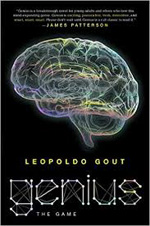 Two hundred of the world’s smartest teenagers are invited to compete in the Game, created by Kiran Biswas, India’s youngest CEO and visionary. Meet three likeable contenders and heroes: Mexican American Rex, programmer (who hacked his way into the game); Nigerian Tunde, self-taught engineering genius; and Painted Wolf, anticorruption activist blogger from Shanghai. They are already Internet buddies, but when they meet in person at the Game, they become family who will fight for each other. As they work to win the competition, they also help each other deal with weighty personal problems that led them to enter the Game. The text is augmented with detailed maps, drawings, and diagrams. Rotating points of view move the action forward at a fast pace as the trio face moral choices at every turn and discover that the Game is not at all what they thought it was.
Two hundred of the world’s smartest teenagers are invited to compete in the Game, created by Kiran Biswas, India’s youngest CEO and visionary. Meet three likeable contenders and heroes: Mexican American Rex, programmer (who hacked his way into the game); Nigerian Tunde, self-taught engineering genius; and Painted Wolf, anticorruption activist blogger from Shanghai. They are already Internet buddies, but when they meet in person at the Game, they become family who will fight for each other. As they work to win the competition, they also help each other deal with weighty personal problems that led them to enter the Game. The text is augmented with detailed maps, drawings, and diagrams. Rotating points of view move the action forward at a fast pace as the trio face moral choices at every turn and discover that the Game is not at all what they thought it was.
Swarm (Zeroes #2). Scott Westerfeld, Margo Lanagan, and Deborah Biancotti. 2016. Simon & Schuster.
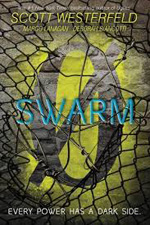 Three award-winning authors team up to write this fast-paced cinematic second book in the Zeroes science fiction series. The Zeroes, a group of six supernaturally gifted adolescents who fight crime, have opened an underground teen nightclub in their hometown of Cambria, California, to hone their amazing powers. When two interlopers with crowd-chaos powers crash the nightclub, create mass confusion, and then disappear into the night, the Zeroes follow their trail to a mall in the desert. They encounter another ominous evil teen, Swarm, who can manipulate crowds to commit bloodthirsty murderous deeds. The Zeroes become Swarm’s next target. Swarm takes control of the police in a funeral procession, directing them to march zombie-like to the nightclub, where the Zeroes must fight for their lives. Told from the distinctive viewpoints of members of the Zeroes, this thrilling novel takes readers on a wild ride, ending with a cliffhanger that will propel them into the sequel.
Three award-winning authors team up to write this fast-paced cinematic second book in the Zeroes science fiction series. The Zeroes, a group of six supernaturally gifted adolescents who fight crime, have opened an underground teen nightclub in their hometown of Cambria, California, to hone their amazing powers. When two interlopers with crowd-chaos powers crash the nightclub, create mass confusion, and then disappear into the night, the Zeroes follow their trail to a mall in the desert. They encounter another ominous evil teen, Swarm, who can manipulate crowds to commit bloodthirsty murderous deeds. The Zeroes become Swarm’s next target. Swarm takes control of the police in a funeral procession, directing them to march zombie-like to the nightclub, where the Zeroes must fight for their lives. Told from the distinctive viewpoints of members of the Zeroes, this thrilling novel takes readers on a wild ride, ending with a cliffhanger that will propel them into the sequel.
Nancy Brashear is Professor Emeritus of English at Azusa Pacific University, in Azusa, CA.
These reviews are submitted by members of the International Literacy Association's Children's Literature and Reading Special Interest Group (CL/R SIG) and are published weekly on Literacy Daily.